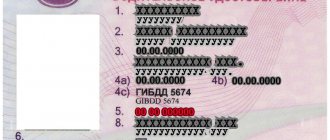There are two types of rights: national ID and international. The main difference between them lies in the name itself - some allow you to move freely throughout the territory of the Russian Federation, others - in all countries of the world. International or national driver's license - what to choose for traveling abroad, in Russia and the CIS countries?
It is very important to remember that the procedures for obtaining, the cost, and the arrangement of points for the two types of this document are different. Moreover, there are differences in the obtaining procedure. All drivers who have a national license but want to travel abroad should know what an international standard license looks like and what procedures must be followed to obtain it.
National ID and regular driving license
A few words about national rights. Firstly, they operate exclusively on the territory of our country. Secondly, there are never any difficulties in obtaining them, because they are issued in almost all traffic police departments of all more or less large cities. Sometimes the interaction between a citizen and an authority is complicated by the fact that the rights were seized in one city, and he declares their return in another.
Standard licenses include the following information about the driver:
- last name, first name and patronymic;
- serial number and series;
- photo;
- place, date of birth and address;
- acceptable transport categories;
- date of issue.
All specified data is in Russian in two forms: Cyrillic characters and Latin letters (transliteration).
A standard license is awarded only after he passes all the necessary exams and pays the state fee. The fee is 500 rubles if the driver wants a license in paper form and 2000 rubles if in plastic.
What does it look like
A driver’s license, regardless of what year it was issued, is a physical medium on which certain information is written:
- surname, name, patronymic of the owner of the rights;
- personal photograph;
- a category that shows what type of transport an individual can drive;
- place of issue of the certificate, etc.
The question of whether this document can be presented as identification is still controversial. In practice, the situation has developed that “rights” are secondary after an internal and (or) international passport. Since they contain personal data and a photograph of the owner, and they were issued by a government agency, it is quite possible to present them to prove your identity.
Features of the visual appearance of the national driver's license
The main purpose of this document is to serve as proof that the owner of the document has the legal right to drive transport on the territory of the Russian Federation.
If we are talking about international rights, then this document has a slightly different meaning and method of application. If in the Russian Federation it is allowed to drive with only one license - a national one, resembling a bank card in shape, then abroad, in addition to the usual license, you must present an international one.
International and national rights cannot be mutually exclusive! Driving around Russia with an international license is prohibited if the driver does not have a regular, national one. The standard document is more significant; it is the one that certifies the right to drive transport.
Therefore, the driver does not have a choice: which driver’s license is better, national or international, since one is impossible without the other.
There are three documents that fully describe the required format of rights in Russia and regulate their application:
- Government Decree No. 1097 of June 24, 2014.
- Traffic rules
- Orders of various institutions, in particular the Ministry of Internal Affairs.
To understand what a national driver's license looks like, what an international ID card looks like, and why this is so, you should turn to an older type of document. The visual appearance implies approximately the same standards as the standard document allowing drivers to move on the roads 20-30 years ago. There are, of course, some changes and additions, but the main essence remains the same. The changes affected the color of the ID, the location of security signs, points, etc.
To date, the country has approved a new generation of national IDs, which are approved internationally by the Vienna Convention.
The national driver's license has the following features:
- the document is a hard plastic product;
- on the left side of the card there is a red oval-shaped “RUS” emblem, symbolizing the state in which these rights are an identification document;
- a list of items that discloses information about the owner of the document;
- on the back there is a barcode and a table with categories allowed for driving, their opening and closing dates;
- ID series and number;
- abbreviations and notes (located below the category table);
- signature and photograph.
The rights also contain information printed in Latin letters. In international law everything is very similar, however, there is also a translation into French.
Where is a Russian ID valid?
The answer to this question lies in two conventions - Geneva and Vienna. Countries that have signed the Vienna Convention recognize on the territory of their countries the national standard of any country of residence, provided that certain points are met. States that have signed the Geneva Convention do not recognize national military institutions on the territories of their states, only international ones. Accordingly, countries that have not signed more than one convention recognize only their local driver’s documents.
Thus, Russian national IDs are valid in a whole list of countries, including: Austria, the Bahamas, Belarus, Belgium, Brazil, Great Britain, Hungary and further in the alphabetical list, which can be found below.
What is an international driving license?
International law (IDL) is a document that performs different functions, looks different and requires different procedures. The goal is to meet the international standard. Let's take a closer look.
The difference between the two certificates lies, first of all, in convenience - traffic inspectors abroad are trained to recognize special types of documents.
The outer side contains:
- Name of authority and date of issue.
- Validity.
- Number and series.
- A state in which the owner of the rights is a citizen.
The reverse side contains a list of states in whose territory the document will have legal force.
International rights are an addition, a license that expands the capabilities of the main document. The IDP does not even contain the driver’s name, and is linked to national ones only by the series and number of the document.
Not all countries require exactly the international standard of rights from Russian citizens. There are countries (mainly the CIS) where the usual standard is suitable. For example, the legislation of Armenia and Georgia allows you to travel within the state using regular IDs. Very often, in some countries, employees require an IDP. This may mean that the employee is either poorly versed in the law or is demanding a bribe.
When receiving an IDP, you must pay a state fee of 1,600 rubles. The dimensions of international rights are slightly larger than those of standard ones.
IDPs are printed in two languages: Russian and French. The document contains special oval-shaped seals. Photos of the international ID are also larger in size and are marked with special stamps.
The appearance of this document provides the following features:
- rights are issued in the form of a book, not a card;
- at the top of the document the name of the state in which the certificate was issued is marked in golden colors;
- four sheets inside the brochure have a translation from French and transliteration of Russian words;
- the “RUS” emblem is indicated under the golden name of the state;
- the name of the certificate, series and number are indicated in the center;
- Near the marks with the names of acceptable categories there is a matte photograph of the driver.
International rights are printed in two languages: Russian and French. The document contains special oval-shaped seals. This way the categories of vehicles that the driver has the right to drive are marked. Photos of the international ID are also larger in size, and here they are marked with special stamps.
Where is it issued?
Where are the national driving licenses issued? This is another question without a specific answer. You can request and reissue this paper in various places. Each driver decides for himself where to turn for help in this or that case.
Today, the initial registration of rights is usually carried out through the MREO, the traffic police. You can request a document through “GosGosDriver’s License”.
Now what? Next, the citizen will have to take pre-prepared certificates, and then come to the traffic police or MFC and pick up the driver’s card.
National and international driving licenses: important differences
As we have seen, the differences between the two different types of driver's licenses are quite significant.
Let us note seven criteria by which differences between documents should be assessed:
- Typical differences.
- Passing a medical commission.
- A set of necessary documents.
- Receipt procedure.
- Education.
- Amount of penalties for violations.
- Price.
Let's take a closer look at each of the criteria.
We will present typical differences between certificates in the form of a special table:
| Type of difference | National rights of Russia | International rights |
| Functionality and objectives of the document | Allows you to manage transport on the territory of the Russian Federation | Allows you to drive vehicles outside the Russian Federation |
| Appearance | Two types: · plastic (card 5.4x6.6 cm); · book (2 sheets of A6 format). | The book is made on thick paper, format – A6. |
| Chroma | White with pink tints, watermarks present. | The cover is gray, the inner block is white. |
| Protection level | · holograms; · special deep color gradients; · “State Traffic Police” stamp and system code protected by law; · barcode. | Availability of seals in round and oval shapes. |
| Filling with data | Computer printing | Computer printing or manual entry. |
| Validity | 10 years | 3 years |
| State duty upon registration | · plastic card – 2000 rubles; · paper format – 500 rubles. | 1600 rubles. |
| Availability of insurance | Through a special policy. | Through a special foreign policy. |
Thanks to new changes in legislation, from 1.01.18 to 1.01.19 it is possible to receive a 30% discount on registration of state fees. To do this, you should apply for a driver’s license through the State Services website.
The discount applies to registration of both national and international rights.
Replacing rights
After 10 years of validity of the national driver's license, it must be replaced with a new one. You can do this:
- at the State Traffic Inspectorate;
- through the Multifunctional Center;
- using the State Services portal remotely.
Regardless of the place where rights are exchanged, you must provide:
- application for a new certificate;
- medical certificate confirming fitness to drive;
- a receipt for payment of state duty in the amount of 2000 rubles.
The speed of issuance may vary - from 1 hour to 9 working days. At the same time, in the regions of Russia, a driver’s license can be obtained at the MFC within 24 hours. But in Moscow, issuance can last up to a week.
Passing a medical examination
There are many situations in which a driver should change his license: its validity period has expired, a replacement or exchange for a newer one is required, the license was returned after an arrest, etc. (there are many reasons why a driver’s license can be revoked and all of them are prescribed by Russian legislation and the theory of the state and TGP rights). Each time the driver needs to follow one procedure - undergo a medical examination.
In this matter there are also significant differences between the two types of documents. When receiving, restoring or returning a RF TDP, the need to submit a medical form is mandatory. When receiving an addition to your license in the form of an IDP, a certificate is not required.
When receiving a standard type document, a medical certificate must be provided if we are talking about changing the driver’s personal data, for example, first or last name.
This procedure is also mandatory if:
- the driver opens another category;
- there is a loss of identification;
- the driver needs a duplicate.
The IDP, being rather an addition to an existing document, is created on the basis of data already noted in national rights.
Thus, the very presence of an IDP implies passing a medical commission. If a driver wishes to open another driving category, but his medical certificate is still valid, he should not obtain a new one. All medical certificates are valid for 1 year. They can be extended by passing a second commission.
Duration and scope of application of IDP and DDP
Confusion often arises with the use of car licenses.
This is explained by the fact that today in Russia old and new models of rights are still used, as well as different rules for their recognition abroad. DDPs issued before 2011 by foreign authorities are not recognized as not meeting international standards.
New DDPs are accepted in countries that are parties to the Vienna Convention on Road Traffic of 1968. In theory, these states should not require international rights. Although in practice this sometimes poses problems. You can view the list of these countries at the traffic police department in your city or via the Internet.
States that have not signed the above convention always require the provision of an IDP. Some of them are parties to the 1949 Geneva Convention or have not signed anything at all. No Russian licenses will be valid in these countries , but they must also be carried with you along with international ones. In Russia, only local documents are valid.
What distinguishes an international driver's license from a regular one is their validity period. Our car licenses are issued to drivers for a ten-year period. But IDPs are valid for only three years . Moreover, their term cannot exceed the term of the DDP, even when three years have not yet expired.
Set of necessary documents
To obtain a DDP and an IDP, sets of documentation are required, which differ from each other.
For standard rights you need:
- Citizen's passport and birth certificate.
- Previous DDPs, if any.
- Medical certificate, if you have one and it has not expired.
- Certificate of passing examinations (if required).
- Photo.
In order to receive the long-awaited certificate, you need to prepare a set of relevant documents. After the traffic police officer has checked all the documents, he checks the relationship between their contents and the driver’s statement. After this, if everything is normal, the process of creating a document and entering information into the database begins. A process that in one way or another precedes the receipt of a document.
The IDP provides for:
- NVU.
- Citizen's passport.
- International passport.
- Photo.
As for obtaining a visa, in the case of a standard ID, it is required, but not with an international one.
Receipt procedure
The procedure for obtaining both types of rights is quite similar, but there are differences.
A striking example is fines: if fines are not paid, then there is no chance of getting new rights, regardless of their type. There are differences in the procedure for obtaining them, primarily in matters of relationship with visas.
For example, to obtain an international document you need:
- visa application;
- foreign passport;
- certificate of good conduct (not always);
- other documentary details required for traveling to another state.
Standard licenses do not require this, because they allow you to move around the Russian Federation. However, the exception, of course, is when the driver plans to visit countries that are present in the Geneva Convention.
Passing exams is a time-consuming procedure that is sometimes very tedious for drivers; it is not required at all to obtain an IDP.
National licenses take about 30 days to produce, and international licenses in less than one hour.
Which is better
In any case, in order to legally drive a car, you must obtain a driver's license. It is impossible to move around the Russian Federation without a national model.
Therefore, the question of which certificate is best to obtain is not entirely correct. But whether to apply for an international document is the right of a resident of Russia. Traveling abroad by car without a special license cannot be made if the legislation of a foreign state provides for such a rule.
Once again, it is worth noting that in 2021, “paper” driver’s licenses are no longer issued - only a plastic carrier with special protection and insignia.
Learning differences
Training is the basis of driving, an integral process through which, one way or another, all drivers who either obtain a license for the first time or open a new category must go through.
When it comes to training, the difference is also great. When obtaining a standard license, a driving school is of great importance and is a necessary requirement if:
- This is the first time a certificate has been issued.
- A new category is opening.
- The arrest has come to an end.
In the case of an IDP, training is not required, nor is passing the relevant exams. The document will be issued on the basis of fundamental rights.
Important aspects
With the entry into force of the new regulations for the national driver's license exam in mid-October, the rules for its admission have changed.
Accordingly, an interested person can submit documents to the traffic police in any region of the Federation, without taking into account his place of residence.
The cost of training at driving schools across the country varies greatly. In large cities it is several times higher than in other populated areas.
It is due to:
| Indicators | Description |
| Cost of classroom equipment | their equipment |
| Models of car simulators | their condition |
| Make and technical condition of cars | used for practical training |
| The driving school has its own racing track | — |
An important factor is the level of knowledge of the teaching staff, their experience, and the qualifications of the instructors who conduct driving lessons.
Their skill is demonstrated by the training course and their preparedness to conduct classes from a psychological perspective, which depends on the ability to find a common language with the people being trained.
Punishment for violation
All types of punishments, in particular for traffic violations, are always clearly established in accordance with the legislation of the country in which the law was violated.
It could be:
- non-compliance with the rules on the road;
- ignorance of blood alcohol standards (each country has its own standard);
- ignorance of the reasons for arrest (in the USA, for example, the reason for arrest is often something that in Russia is punishable by a fine).
Drivers should remember that before visiting other countries, it is very important to understand foreign traffic rules, since the degree of punishment for their violations in another state is very different from Russian ones. Most problems on the road occur precisely because of ignorance of the laws.
The position of the steering wheel is also important. You should be especially careful in countries with right-hand drive traffic, for example, in Britain or Japan. Statistics show that most of the violating tourists and migrants come from “left-hand drive” countries. Good legal knowledge can mean a lot even for tourists who are in the country for just a few days.
There are many examples of problems due to ignorance of the laws of other countries, starting with a man who did not turn on his turn signal when approaching a car and paid more than 500 euros in fine and a woman who was arrested because her child was not wearing a seat belt and was not in child car seat.










